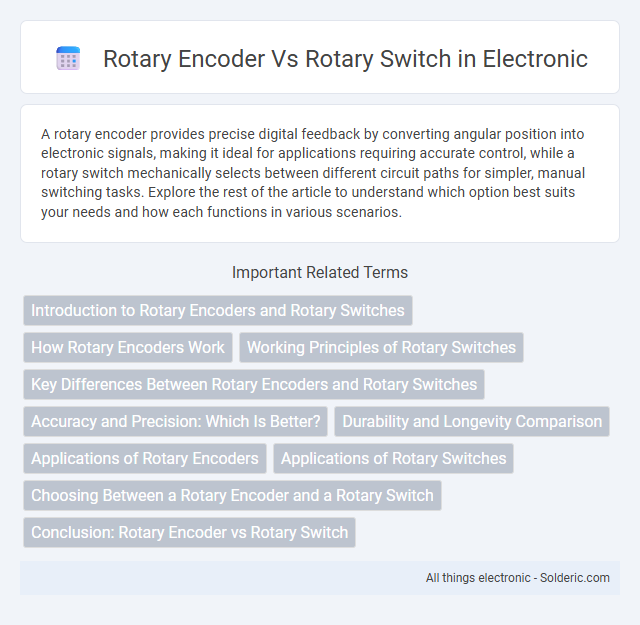A rotary encoder provides precise digital feedback by converting angular position into electronic signals, making it ideal for applications requiring accurate control, while a rotary switch mechanically selects between different circuit paths for simpler, manual switching tasks. Explore the rest of the article to understand which option best suits your needs and how each functions in various scenarios.
Comparison Table
| Feature | Rotary Encoder | Rotary Switch |
|---|---|---|
| Function | Converts rotational position into digital signals | Selects one of many electrical circuits by rotating |
| Output | Incremental or absolute digital pulses | Discrete electrical contacts (on/off states) |
| Use Case | Position sensing, user input devices, industrial automation | Mode selection, circuit routing, device configuration |
| Resolution | High, depending on encoder type (e.g., 12-bit, 14-bit) | Limited by number of switch positions (commonly 2-12) |
| Durability | Long; electronic with no physical contacts wearing | Mechanical contacts subject to wear over time |
| Electrical Contact | Contactless (optical or magnetic sensors) | Mechanical contact based |
| Complexity | Higher; requires signal processing | Simple; direct switching |
| Typical Applications | Robotics, CNC machines, digital volume controls | Appliance control panels, audio selectors, mode switches |
Introduction to Rotary Encoders and Rotary Switches
Rotary encoders provide precise digital feedback by converting angular positions into electrical signals, enabling accurate control in applications like robotics and industrial machinery. Rotary switches mechanically change circuit paths to select different functions or modes, commonly used in consumer electronics and control panels. Your choice between the two depends on whether you need continuous position sensing with high resolution or discrete switch positions for simple selection.
How Rotary Encoders Work
Rotary encoders function by converting the angular position or motion of a shaft into digital signals using optical, magnetic, or mechanical sensors. These sensors detect incremental or absolute position changes by interpreting patterns or magnetic fields on a rotating disc attached to the shaft. The generated digital signals enable precise control and feedback in applications such as motor speed control, robotics, and industrial automation.
Working Principles of Rotary Switches
Rotary switches operate through a mechanically rotating contact arm that moves between multiple fixed terminals, allowing the user to select distinct electrical circuits by physically connecting different contacts. This switching mechanism enables discrete position settings, often used for selecting modes or channels in electronic devices. Unlike rotary encoders that generate digital signals via optical or magnetic sensing, rotary switches provide direct mechanical contact for circuit completion.
Key Differences Between Rotary Encoders and Rotary Switches
Rotary encoders provide precise digital position feedback, converting angular motion into electronic signals for accurate control systems, while rotary switches mechanically connect circuits in discrete positions without position feedback. Encoders are ideal for applications requiring continuous monitoring, such as robotics and CNC machines, whereas rotary switches are suited for selecting fixed electrical pathways in devices like audio and lighting equipment. Understanding these differences helps you choose the right component for your project's control and signal requirements.
Accuracy and Precision: Which Is Better?
Rotary encoders provide higher accuracy and precision compared to rotary switches due to their ability to detect fine angular displacement with digital output signals, enabling exact position measurement. Rotary switches offer discrete positions and mechanical detents, limiting their precision to predefined steps rather than continuous feedback. Your application's accuracy requirements will determine if a rotary encoder's exact resolution or a rotary switch's simplicity best suits your needs.
Durability and Longevity Comparison
Rotary encoders typically offer greater durability and longevity compared to rotary switches due to their contactless sensing technology, which reduces wear and tear over time. Rotary switches rely on mechanical contacts that can degrade with repeated use, leading to potential failure or the need for replacement. Choosing a rotary encoder ensures more reliable performance and extended lifespan, especially in applications requiring frequent or precise rotation.
Applications of Rotary Encoders
Rotary encoders are widely used in industrial automation, robotics, and CNC machinery for precise position and speed sensing. They provide feedback in motor control systems, enabling accurate motion tracking in applications such as conveyor belts and servo drives. High-resolution rotary encoders are also essential in medical imaging devices and instrumentation for enhanced control and measurement accuracy.
Applications of Rotary Switches
Rotary switches are widely used in applications requiring the selection of multiple electrical circuits, such as in audio equipment, industrial machinery, and control panels. They provide precise mechanical feedback for selecting discrete positions, making them ideal for mode selection and function switching. Your control systems benefit from the rotary switch's durability and simplicity in managing complex routing tasks without digital encoding.
Choosing Between a Rotary Encoder and a Rotary Switch
Choosing between a rotary encoder and a rotary switch depends on your application requirements for precision and feedback. A rotary encoder provides high-resolution digital signals for accurate position tracking and is ideal for applications needing fine control, such as volume knobs or robotic arms. Conversely, a rotary switch offers discrete mechanical positions for simple on/off or mode selection tasks, making it suitable for applications where distinct, fixed settings are necessary.
Conclusion: Rotary Encoder vs Rotary Switch
Rotary encoders provide precise digital feedback for electronic systems, making them ideal for applications requiring accurate position or speed control. Rotary switches, however, offer simple multi-position mechanical switching without signal encoding, best suited for straightforward input selection tasks. Understanding your specific control needs will help you choose between the versatile signal output of a rotary encoder and the direct circuit connection of a rotary switch.
rotary encoder vs rotary switch Infographic

 solderic.com
solderic.com